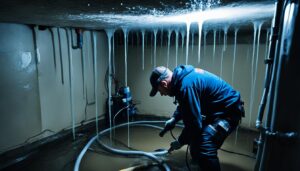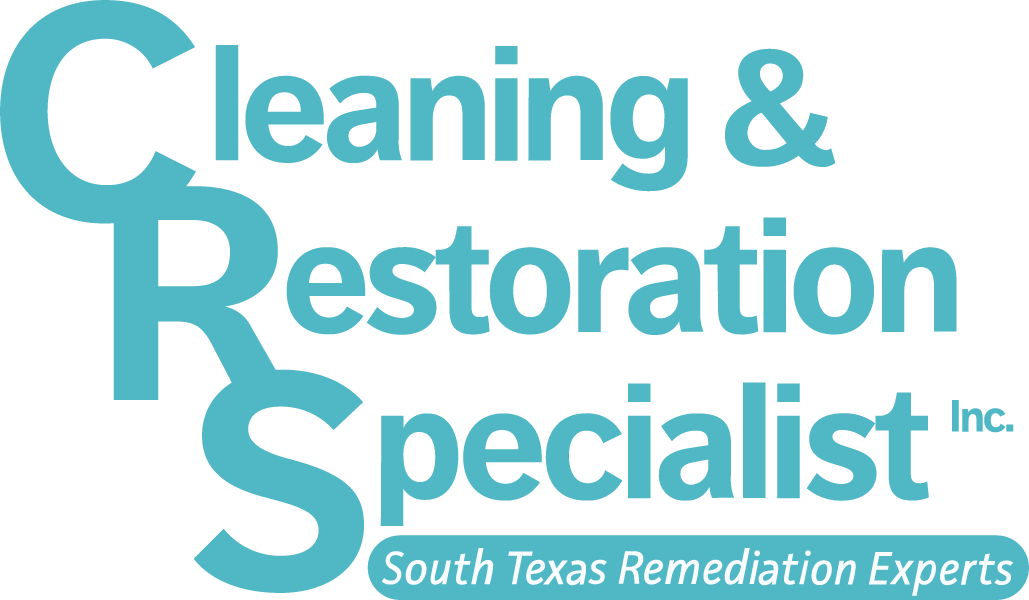Dealing with water damage in your home can be a stressful and overwhelming experience. It’s important to handle the situation carefully to prevent further damage and costly mistakes. In this section, we will provide you with expert tips on how to safeguard your property and avoid common pitfalls when faced with water damage.
Key Takeaways:
- Act quickly to prevent further damage.
- Don’t delay in calling a professional restoration company.
- Avoid using electrical appliances in flooded areas.
- Ensure proper drying and dehumidification.
- Never ignore hidden water damage.
Act Quickly to Prevent Further Damage
When it comes to water damage in your home, acting quickly is of utmost importance. The longer you wait to address the issue, the more extensive and costly the damage can become. To prevent further damage and mitigate the impact of water damage, you need to take immediate action.
One of the reasons why you should act promptly is to minimize the risk of structural damage to your home. Water can weaken the foundation, walls, and floors, compromising the structural integrity of your property. By addressing the issue promptly, you can prevent potential collapse or long-term damage that could potentially lead to expensive repairs or reconstruction.
Another reason to act quickly is to prevent mold growth. Excess moisture from water damage creates the ideal environment for mold to thrive. Mold can spread rapidly and release allergens and irritants into the air, posing health risks to you and your family. By addressing the water damage promptly, you can minimize the chances of mold growth and protect your indoor air quality.
Steps to Prevent Further Damage:
1. Shut off the water source: If possible, stop the water flow to minimize the amount of water accumulating in your home.
2. Remove standing water: Use buckets, mops, or wet/dry vacuums to remove any standing water from your property.
3. Dry affected areas: Use fans, dehumidifiers, or open windows to help speed up the drying process and remove excess moisture from the air.
4. Salvage valuable items: Move furniture, electronics, and other valuable items to a dry area to prevent further damage.
5. Document the damage: Take photographs or videos of the affected areas and damaged items for insurance purposes.
6. Seek professional assistance: Contact a reputable water damage restoration company to assess the extent of the damage and provide appropriate solutions.
Remember, acting quickly is essential to prevent further damage and protect your home. By following these steps, you can minimize the impact of water damage and expedite the restoration process.
Don’t Delay in Calling a Professional Restoration Company
If your home has experienced water damage, it’s crucial not to delay in calling a professional restoration company. Waiting too long can worsen the damage and lead to more extensive and costly repairs. Seeking immediate help from a professional can make all the difference in the restoration process.
When it comes to water damage, time is of the essence. The longer you wait, the more opportunity there is for water to seep into structural components, causing further deterioration and potentially compromising the integrity of your home. By acting promptly and calling a professional restoration company, you can mitigate additional damage and save yourself from unnecessary expenses.
Professional restoration companies have the expertise, experience, and necessary equipment to handle water damage effectively. They understand the complexities involved and can provide comprehensive solutions tailored to your specific situation. From water extraction and drying to mold remediation and repairs, they have the knowledge and resources to restore your home back to its pre-damaged condition.
Moreover, professional restoration companies employ trained technicians who are familiar with industry best practices and safety protocols. They follow strict guidelines to ensure that the restoration process is conducted efficiently and safely. Attempting to handle water damage on your own may lead to inadequate results and potentially pose risks to your health and safety.
By reaching out to a professional restoration company promptly, you’ll also benefit from their ability to assess the extent of the damage accurately. They can identify any hidden issues and develop a tailored plan for restoration, addressing both the visible and underlying damage. This proactive approach can prevent long-term problems and protect your investment.
Remember, when it comes to water damage, every minute counts. Don’t delay in reaching out to a professional restoration company, as prompt action can make a significant difference in the outcome. Contacting experts allows you to leverage their knowledge, skills, and resources to mitigate the damage effectively, restore your home, and bring peace of mind to you and your family.
Call us today at (210) 791-6401 for professional restoration services!
Avoid Using Electrical Appliances in Flooded Areas
When dealing with water damage in your home, it is crucial to prioritize safety. One important measure to take is to avoid using electrical appliances in flooded areas. It may be tempting to try and salvage your appliances, but doing so can put you at risk of severe hazards.
Water is a conductor of electricity, and when it comes into contact with electrical appliances, there is a high chance of electrical shock or even a fire. The combination of water and electricity can be extremely dangerous, putting both you and your property at risk.
It’s essential to understand the potential risks involved in using electrical appliances in flooded areas. Water can seep into the internal components of the appliances, causing damage and rendering them unsafe to use. Additionally, the presence of moisture can lead to short circuits and electrical failures, potentially resulting in fires.
Instead of attempting to use or repair water-damaged electrical appliances yourself, it is advisable to seek the assistance of a qualified professional. They have the knowledge and expertise to safely assess and handle the situation, minimizing the risk of further damage or injury.
To provide a clear picture of the dangers associated with using electrical appliances in flooded areas, let’s take a look at the potential hazards:
| Potential Hazards of Using Electrical Appliances in Flooded Areas |
|---|
| Danger of electrical shock due to water conductivity |
| Increased risk of fire |
| Internal damage to appliances, rendering them unsafe |
| Potential for short circuits and electrical failures |
By understanding these risks, you can make informed decisions and prioritize your safety when dealing with water damage situations. Always remember that the safety of you and your family should be the top priority.
Next, in Section 5, we will explore the importance of proper drying and dehumidification in preventing long-term damage caused by excess moisture.
Do Not Neglect Proper Drying and Dehumidification
Properly drying and dehumidifying your home is crucial in preventing long-term damage caused by excess moisture. Neglecting these essential steps can lead to the growth of mold and structural issues. It’s important to prioritize the drying and dehumidification process to ensure a safe and healthy environment for you and your family.
Excess moisture can seep into the walls, floors, and furniture of your home, creating the perfect breeding ground for mold and mildew. Not only can mold cause serious health issues, but it can also damage your property and belongings. Damp environments can also lead to structural issues such as rotting wood and weakened foundations.
By properly drying and dehumidifying your home, you can effectively mitigate these risks and protect your investment. Here are some key steps to follow:
- Identify the source of the moisture: Before you can effectively dry and dehumidify your home, it’s important to locate the source of the excess moisture. Whether it’s a burst pipe, a leaking roof, or poor ventilation, addressing the root cause will prevent further damage.
- Remove standing water: If there is standing water in your home, use a wet-dry vacuum or a pump to remove it. Standing water can prolong the drying process and increase the risk of mold growth.
- Use fans and dehumidifiers: Position fans and dehumidifiers strategically to circulate the air and remove moisture from the environment. This will help accelerate the drying process and reduce humidity levels.
- Open windows and doors: If weather permits, open windows and doors to increase airflow and aid in the drying process. However, be cautious of outdoor humidity levels that may impede drying.
- Monitor moisture levels: Use a moisture meter to regularly check the moisture levels in your home. This will allow you to track progress and ensure that the drying process is effective.
By following these steps and taking proactive measures, you can prevent long-term damage and safeguard your home. Remember, proper drying and dehumidification contribute to a healthier environment and ensure the longevity of your property.
Next, we will explore the importance of never ignoring hidden water damage and how to identify and address it promptly.
Never Ignore Hidden Water Damage
Water damage can be a sneaky problem. It’s not always easily visible, and ignoring hidden signs can lead to serious consequences for your home. To protect your property and prevent costly repairs, it’s crucial to identify hidden water damage and address it promptly.
So how can you spot hidden water damage? Keep an eye out for these common indicators:
- Water stains on walls or ceilings
- Musty odors or a persistent dampness in certain areas
- Peeling or bubbling paint
- Warped or buckling flooring
- Visible mold growth
If you notice any of these signs, don’t wait. Take immediate action to investigate and address the issue. Ignoring hidden water damage can lead to further structural damage, mold growth, and even compromise the health and safety of your household members.
By promptly addressing hidden water damage, you can prevent a minor issue from turning into a major catastrophe. Calling a professional restoration company is highly recommended. They have the expertise, tools, and experience to assess the extent of the damage and develop an appropriate restoration plan.
Remember, prevention is always better than cure. Regularly inspecting your home for hidden water damage and taking proactive measures can save you time, money, and stress in the long run.
Don’t ignore the signs. Protect your home from hidden water damage and ensure the safety and integrity of your living environment.
| Signs of Hidden Water Damage | Actions to Take |
|---|---|
| Water stains on walls or ceilings | Investigate the source of the leak and repair it immediately. Check for hidden moisture and consider professional drying services. |
| Musty odors or dampness | Inspect the area for water leaks or excessive moisture. Use dehumidifiers to reduce humidity levels and prevent mold growth. |
| Peeling or bubbling paint | Identify the underlying cause, such as water infiltration or high humidity. Fix the issue and repaint the affected area. |
| Warped or buckling flooring | Check for water leaks or plumbing issues. Repair or replace the damaged flooring to prevent further water damage. |
| Visible mold growth | Immediately address the mold issue by hiring a professional mold remediation service. Identify and fix the underlying moisture problem. |
Conclusion
In conclusion, taking the right steps to handle water damage is crucial for protecting your home. By acting quickly, you can prevent further damage and minimize the extent of repairs. Don’t delay in calling a professional restoration company, as their expertise can make a significant difference in the restoration process.
Avoid using electrical appliances in flooded areas to prevent potential hazards and ensure your safety. Properly drying and dehumidifying your home is essential in preventing long-term damage, such as mold growth and structural issues. Never ignore hidden water damage, as addressing it promptly can save you from costly consequences in the future.
By following these expert tips and avoiding common mistakes, you can safeguard your property and avoid unnecessary expenses. Remember, protecting your home from water damage requires swift action, professional assistance, and a thorough approach to drying and addressing hidden damage. Take these crucial steps to ensure the well-being of your home and your peace of mind.
FAQ
Why is acting quickly important when dealing with water damage?
Acting quickly is important when dealing with water damage because it can help prevent further damage to your home. The longer water sits, the more damage it can cause, including structural issues, mold growth, and damage to personal belongings.
When should I call a professional restoration company?
It is important not to delay in calling a professional restoration company when dealing with water damage. They have the expertise and equipment to handle the situation effectively, preventing further damage and ensuring proper restoration of your property.
Why should I avoid using electrical appliances in flooded areas?
Using electrical appliances in areas affected by water can be extremely dangerous. It can cause electrocution and increase the risk of fire. It is best to keep electrical appliances away from water to prevent accidents and further damage.
Why is proper drying and dehumidification important?
Proper drying and dehumidification are important to prevent mold growth and structural issues. Excess moisture can lead to the growth of mold, which can be harmful to your health and cause damage to your home’s structure. Ensuring thorough drying and dehumidification is vital to maintaining a safe and healthy environment.
Why should I never ignore hidden water damage?
Hidden water damage can have serious consequences if ignored. It can lead to mold growth, deterioration of structural elements, and even compromise the integrity of your home. It is essential to identify and address hidden water damage promptly to prevent further issues and maintain the condition of your property.









